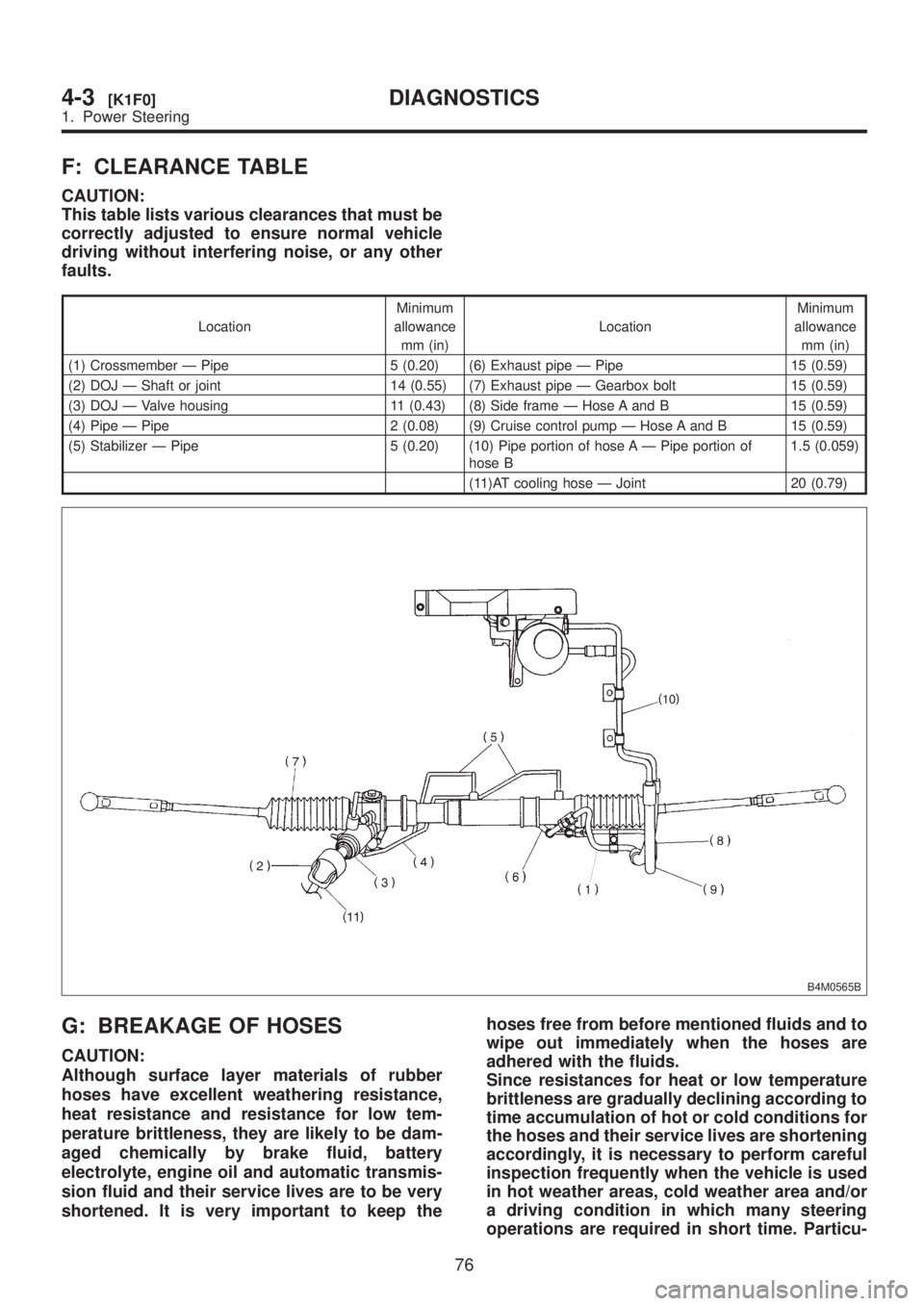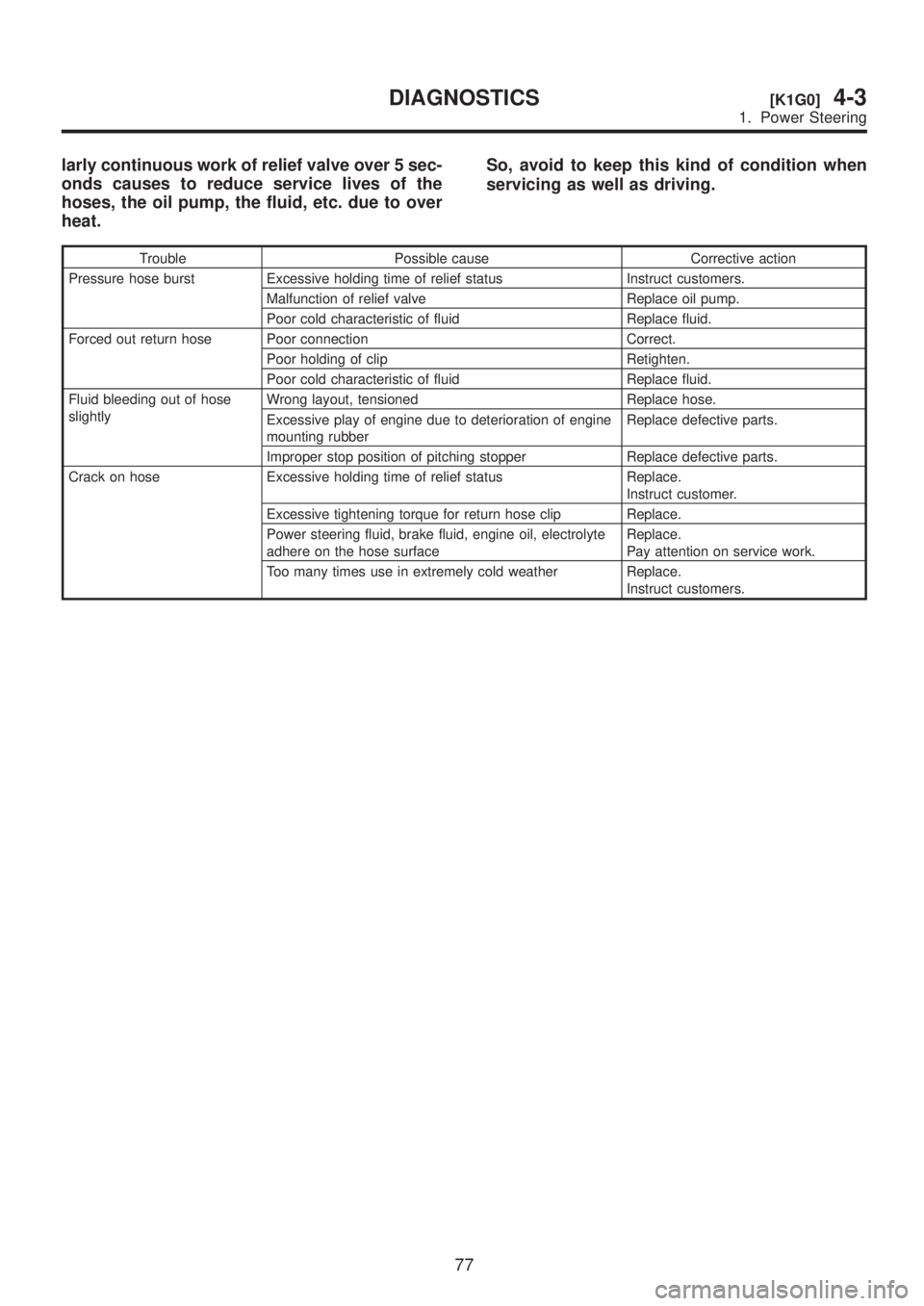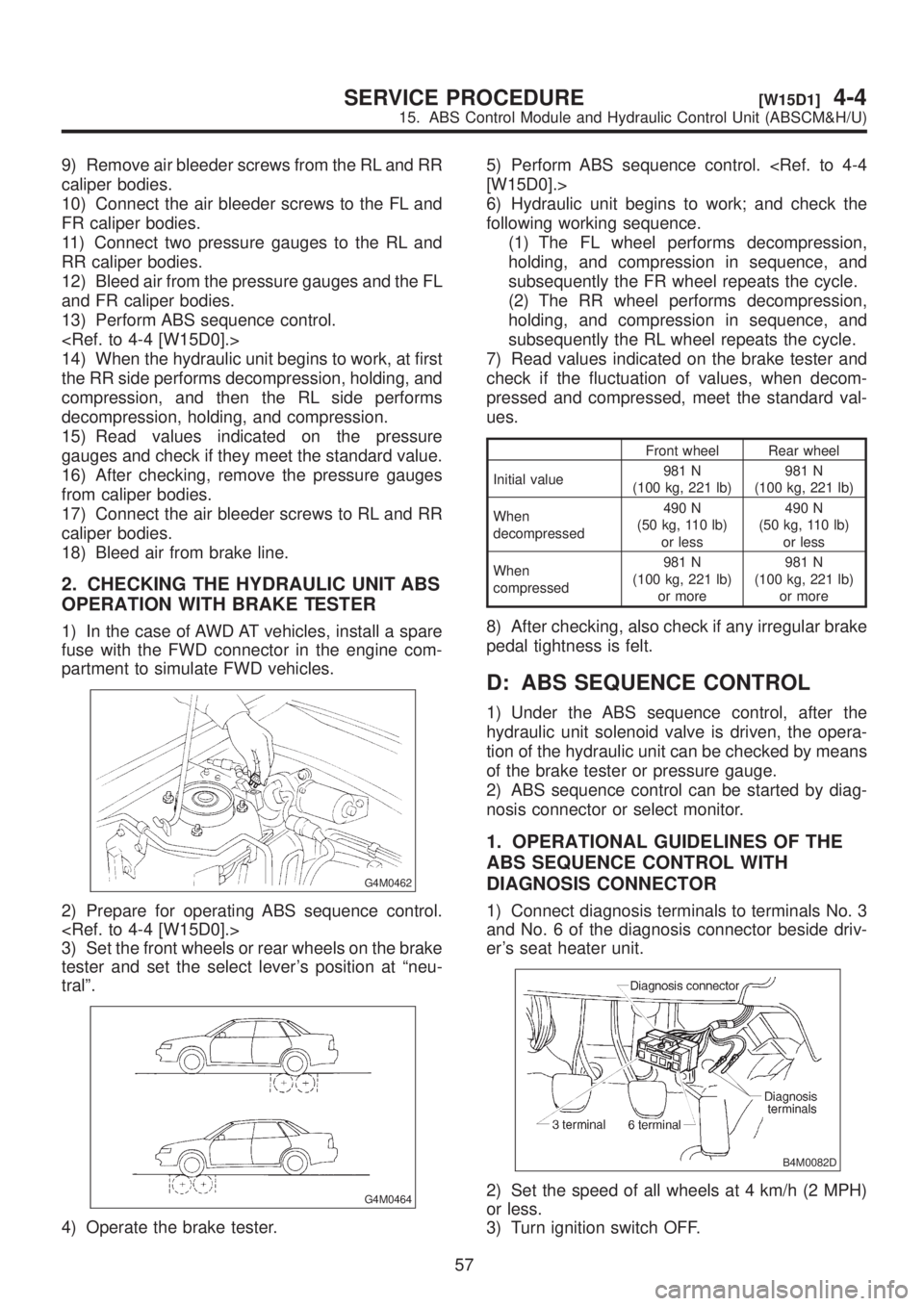Page 671 of 1456
11) Remove propeller shaft.
CAUTION:
When removing propeller shaft, pay attention
not to damage the sliding surfaces of rear drive
shaft (extension) spline, oil seal and sleeve
yoke.
NOTE:
IPrepare an oil can and cap since the transmis-
sion oil flows out from the extension at removing
propeller shaft.
IInsert the cap into the extension to prevent
transmission oil from flowing out immediately after
removing the propeller shaft.
S3M0033A
12) Remove heat sealed cover.
13) Remove clamps and bracket of parking brake
cable.
G3M0053
14) Remove crossmember reinforcement lower
(Sedan only).15) Remove DOJ of rear drive shaft from rear dif-
ferential using ST.
ST 28099PA100 DRIVE SHAFT REMOVER
G3M1020
16) Secure rear drive shaft to rear crossmember
using wire.
G3M1022
17) Remove lower differential bracket.
G3M0054
18) Support rear differential with transmission
jack.
G3M0055
21
[W2B1]3-4SERVICE PROCEDURE
2. Rear Differential
Page 673 of 1456
11) Remove propeller shaft.
CAUTION:
When removing propeller shaft, pay attention
not to damage the sliding surfaces of rear drive
shaft (extension) spline, oil seal and sleeve
yoke.
NOTE:
IPrepare an oil can and cap since the transmis-
sion oil flows out from the extension at removing
propeller shaft.
IInsert the cap into the extension to prevent
transmission oil from flowing out immediately after
removing the propeller shaft.
S3M0033A
12) Remove heat sealed cover.
13) Remove clamps and bracket of parking brake
cable.
G3M0053
14) Remove DOJ of rear drive shaft from rear dif-
ferential.
G3M0257
15) Secure rear drive shaft to rear crossmember
using wire.
G3M0046
16) Remove lower differential bracket.
G3M0054
17) Support rear differential with transmission
jack.
G3M0055
23
[W2B2]3-4SERVICE PROCEDURE
2. Rear Differential
Page 870 of 1456

F: CLEARANCE TABLE
CAUTION:
This table lists various clearances that must be
correctly adjusted to ensure normal vehicle
driving without interfering noise, or any other
faults.
LocationMinimum
allowance
mm (in)LocationMinimum
allowance
mm (in)
(1) Crossmember Ð Pipe 5 (0.20) (6) Exhaust pipe Ð Pipe 15 (0.59)
(2) DOJ Ð Shaft or joint 14 (0.55) (7) Exhaust pipe Ð Gearbox bolt 15 (0.59)
(3) DOJ Ð Valve housing 11 (0.43) (8) Side frame Ð Hose A and B 15 (0.59)
(4) Pipe Ð Pipe 2 (0.08) (9) Cruise control pump Ð Hose A and B 15 (0.59)
(5) Stabilizer Ð Pipe 5 (0.20) (10) Pipe portion of hose A Ð Pipe portion of
hose B1.5 (0.059)
(11)AT cooling hose Ð Joint 20 (0.79)
B4M0565B
G: BREAKAGE OF HOSES
CAUTION:
Although surface layer materials of rubber
hoses have excellent weathering resistance,
heat resistance and resistance for low tem-
perature brittleness, they are likely to be dam-
aged chemically by brake fluid, battery
electrolyte, engine oil and automatic transmis-
sion fluid and their service lives are to be very
shortened. It is very important to keep thehoses free from before mentioned fluids and to
wipe out immediately when the hoses are
adhered with the fluids.
Since resistances for heat or low temperature
brittleness are gradually declining according to
time accumulation of hot or cold conditions for
the hoses and their service lives are shortening
accordingly, it is necessary to perform careful
inspection frequently when the vehicle is used
in hot weather areas, cold weather area and/or
a driving condition in which many steering
operations are required in short time. Particu-
76
4-3[K1F0]DIAGNOSTICS
1. Power Steering
Page 871 of 1456

larly continuous work of relief valve over 5 sec-
onds causes to reduce service lives of the
hoses, the oil pump, the fluid, etc. due to over
heat.So, avoid to keep this kind of condition when
servicing as well as driving.
Trouble Possible cause Corrective action
Pressure hose burst Excessive holding time of relief status Instruct customers.
Malfunction of relief valve Replace oil pump.
Poor cold characteristic of fluid Replace fluid.
Forced out return hose Poor connection Correct.
Poor holding of clip Retighten.
Poor cold characteristic of fluid Replace fluid.
Fluid bleeding out of hose
slightlyWrong layout, tensioned Replace hose.
Excessive play of engine due to deterioration of engine
mounting rubberReplace defective parts.
Improper stop position of pitching stopper Replace defective parts.
Crack on hose Excessive holding time of relief status Replace.
Instruct customer.
Excessive tightening torque for return hose clip Replace.
Power steering fluid, brake fluid, engine oil, electrolyte
adhere on the hose surfaceReplace.
Pay attention on service work.
Too many times use in extremely cold weather Replace.
Instruct customers.
77
[K1G0]4-3DIAGNOSTICS
1. Power Steering
Page 934 of 1456

9) Remove air bleeder screws from the RL and RR
caliper bodies.
10) Connect the air bleeder screws to the FL and
FR caliper bodies.
11) Connect two pressure gauges to the RL and
RR caliper bodies.
12) Bleed air from the pressure gauges and the FL
and FR caliper bodies.
13) Perform ABS sequence control.
14) When the hydraulic unit begins to work, at first
the RR side performs decompression, holding, and
compression, and then the RL side performs
decompression, holding, and compression.
15) Read values indicated on the pressure
gauges and check if they meet the standard value.
16) After checking, remove the pressure gauges
from caliper bodies.
17) Connect the air bleeder screws to RL and RR
caliper bodies.
18) Bleed air from brake line.
2. CHECKING THE HYDRAULIC UNIT ABS
OPERATION WITH BRAKE TESTER
1) In the case of AWD AT vehicles, install a spare
fuse with the FWD connector in the engine com-
partment to simulate FWD vehicles.
G4M0462
2) Prepare for operating ABS sequence control.
3) Set the front wheels or rear wheels on the brake
tester and set the select lever's position at ªneu-
tralº.
G4M0464
4) Operate the brake tester.5) Perform ABS sequence control.
[W15D0].>
6) Hydraulic unit begins to work; and check the
following working sequence.
(1) The FL wheel performs decompression,
holding, and compression in sequence, and
subsequently the FR wheel repeats the cycle.
(2) The RR wheel performs decompression,
holding, and compression in sequence, and
subsequently the RL wheel repeats the cycle.
7) Read values indicated on the brake tester and
check if the fluctuation of values, when decom-
pressed and compressed, meet the standard val-
ues.
Front wheel Rear wheel
Initial value981 N
(100 kg, 221 lb)981 N
(100 kg, 221 lb)
When
decompressed490 N
(50 kg, 110 lb)
or less490 N
(50 kg, 110 lb)
or less
When
compressed981 N
(100 kg, 221 lb)
or more981 N
(100 kg, 221 lb)
or more
8) After checking, also check if any irregular brake
pedal tightness is felt.
D: ABS SEQUENCE CONTROL
1) Under the ABS sequence control, after the
hydraulic unit solenoid valve is driven, the opera-
tion of the hydraulic unit can be checked by means
of the brake tester or pressure gauge.
2) ABS sequence control can be started by diag-
nosis connector or select monitor.
1. OPERATIONAL GUIDELINES OF THE
ABS SEQUENCE CONTROL WITH
DIAGNOSIS CONNECTOR
1) Connect diagnosis terminals to terminals No. 3
and No. 6 of the diagnosis connector beside driv-
er's seat heater unit.
B4M0082D
2) Set the speed of all wheels at 4 km/h (2 MPH)
or less.
3) Turn ignition switch OFF.
57
[W15D1]4-4SERVICE PROCEDURE
15. ABS Control Module and Hydraulic Control Unit (ABSCM&H/U)
Page 962 of 1456
1. Specifications
A: HEATER SYSTEM
Item Specifications Condition
Heating capacity 4.652 kW (4,000 kcal/h, 15,872 BTU/h) or more ...
When 300 m
3(10,593 cu ft)/hMode selector switch HEAT
Temp. control lever FULL HOT
Temperature difference
between hot water and
inlet air65ÉC (149ÉF)
Hot water flow rate 360(95.1 US
gal, 79.2 Imp
gal)/h
Air flow rate 300 m
3(10,593 cu ft)/h Heat mode (FRESH), FULL HOT at 12.5
V
Max air flow rate 510 m
3(18,008 cu ft)/h Temperature control
leverFULL COLD
Blower fan speed 4th position
RECIRC switch position RECIRC
Heater core size (height´
length´width´thickness)193.5´152.0´25.0´0.9 mm
(7.62´5.98´0.984´0.035 in)Ð
Blower
motorType Magnet motor 230 W or less at 12 V
Fan type and
size
(diameter´
width)Sirocco fan type
150´75 mm (5.91´2.95 in)
Ð
2
4-6[S1A0]SPECIFICATIONS AND SERVICE DATA
1. Specifications
Page 963 of 1456
1. Heater System
B4M0368B
(1) Intake unit
(2) Grommet
(3) Hose (Inlet)
(4) Hose (Outlet)
(5) Heater duct(6) Clamp
(7) Grommet
(8) Heater unit
(9) Rear heater duct
(10) ResistorTightening torque: N´m (kg-m, ft-lb)
T:
7.35±1.96 (0.750±0.200,
5.421
±1.446)
3
[C100]4-6COMPONENT PARTS
1. Heater System
Page 964 of 1456
2. Heater Unit
B4M1080A
(1) Vent lever
(2) Side link
(3) DEF. lever
(4) Heater case upper
(5) Heater grommet
(6) Heater core
(7) Mix door
(8) Heater case lower(9) Mix rod
(10) Mix link
(11) Mix lever
(12) Foot duct (RH)
(13) Foot duct (CTR)
(14) Foot duct (LH)
(15) Foot lever lower
(16) Foot door(17) Vent door
(18) DEF. door
(19) Foot lever upper
Tightening torque: N´m (kg-m, ft-lb)
T:
7.35±1.96 (0.750±0.200,
5.421
±1.446)
4
4-6[C200]COMPONENT PARTS
2. Heater Unit